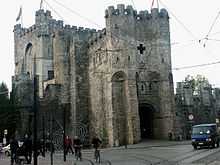Gravensteen
| Gravensteen | |
|---|---|
| Belgium | |
_MM.jpg) | |
| Type | Castle |
| Site information | |

The Gravensteen is a castle in Ghent originating from the Middle Ages. The name means "castle of the count" in Dutch. [1]
History
The present castle was built in 1180 by count Philip of Alsace [2] and was modeled after the crusaders castles that Philip of Alsace encountered while he participated in the second crusade. Before its construction, there stood a wooden castle on the same location, presumably built in the ninth century. The castle served as the seat of the Counts of Flanders until they abandoned it in the 14th century. The castle was then used as a courthouse, a prison and eventually decayed. Houses were built against the walls and even on the courtyard and the stones of the walls were used to erect other buildings. At one time it even served as a factory. At the end of the 19th century, the castle was scheduled to be demolished.
Renovation
In 1885 the city of Ghent bought the castle and started a renovation project. The newly built houses were removed and the walls and dungeon were restored to their original condition.
This renovation has been the subject of discussion. People argue whether the castle can still be considered authentic. Despite these discussions, the Gravensteen attracts huge numbers of tourists.
The castle has been repaired enough to allow people to travel through it and climb on top. It is still partly surrounded by the moat. Inside is a museum with various torture devices (and a guillotine) that were historically used in Ghent.
See also
References
External links
- Visiting information from gent.be
- Gravensteen panorama in 360°
- Gravensteen in the Werbeka Netshop
- Gravensteen and the Château Bizar